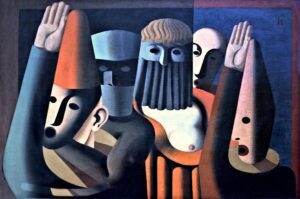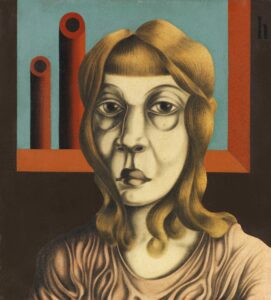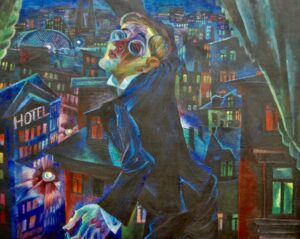New Objectivity, or Neue Sachlichkeit, emerged in Germany as a counter-movement to Expressionism, aiming to depict reality with a stark, unsentimental eye.
It’s a style that’s unflinching in its detail and often critical of the society it portrays.
We’ll jump into its historical context, key characteristics, and lasting influence on the art world.
Stick with us to uncover the essence of New Objectivity and why it still resonates in contemporary culture.
Historical Context Of New Objectivity
The New Objectivity movement surfaced in a Germany ravaged by the aftermath of World War I.
Turmoil and economic strain set the stage for a radical shift in artistic expression – out went the emotional tumult of Expressionism, and in came a focus on sober realism and biting social critique.
Our interest in art movements spans the globe and eras, recognizing that New Objectivity reflected a universal desire for candidness in chaotic times.
Artists like Otto Dix and George Grosz became front-runners, wielding their brushes as weapons against the hypocrisy and corruption they saw.
The movement’s name itself, coined by art historian Gustav Friedrich Hartlaub, encapsulated the ethos of the times.
His 1925 exhibition titled Die Neue Sachlichkeit showcased works steeped in unflinching observation, a stark contrast to the introspection of earlier artistic ideologies.
The zeitgeist of the 1920s and 1930s was one of reexamination and redefinition, and the New objectivity artists captured this sensibility perfectly.

They served as documentarians of their day, capturing the fallout of war, the fragility of democracy, and the rise of industrialism.
These subjects were not just German concerns but global ones, making the movement’s impact far-reaching.
The influence of New Objectivity stretched beyond canvas and gallery walls.
Filmmakers of the era, particularly those in the burgeoning German film industry, found resonance in the movement’s themes.
Films like Metropolis and M borrowed the movement’s stark realism, combining it with a cinematic flair that would influence generations of filmmakers.
Our exploration of New Objectivity reveals a riveting intersection between visual arts and film – each informing and enhancing the other.
This interplay marks a significant moment in our artistic heritage, cementing New Objectivity’s place in the pantheon of movements that have truly shaped the way we perceive and interact with our world.
Key Characteristics Of New Objectivity
When we explore the New Objectivity movement, we find several defining characteristics that set it apart from other art forms.

These characteristics reveal the movement’s underlying principles and help us to better understand the messages its exponents sought to convey.
- Rationality over sentiment: new objectivity artists rejected the emotional subjectivity of Expressionism, favoring a more detached and observational approach to their work.
- Realism and precision: There was a marked interest in depicting the world with sharp clarity and attention to detail.
- Sociopolitical commentary: The artworks often served as critiques of the Weimar Republic, exposing societal ills and corruption.
These attributes allowed New Objectivity to stand as a mirror to the tumultuous period between the wars, reflecting the experience of individuals and commenting on the broader social context.
The employment of straightforward, almost clinical depiction in works like The Skat Players by Otto Dix underscores the movement’s devotion to candid and realistic portrayals.
The use of such unadorned representation was not merely an aesthetic choice but a vehicle for artists to communicate the stark reality of their time.
Another fundamental aspect is the objective portrayal of the human figure.

Artists of the New Objectivity painted individuals with an almost photographic fidelity, often emphasizing the flaws and hardships that were overlooked by more romanticized styles.
The movement also extends its influence into the realm of filmmaking, where directors embraced similar aesthetics and themes.
The bluntness and straightforward storytelling characteristic of New Objectivity films provided a foundation for what would later evolve into film noir and other cinematic movements.
By considering these key characteristics, we gain insights into the unique nature of New Objectivity.
The way this movement captures the essence of its era through unrestrained observation and stark realism remains relevant as it continues to inspire contemporary artists and filmmakers alike.
The Society Portrayed By New Objectivity
The New Objectivity movement painted a stark picture of society, with artists like Otto Dix and George Grosz at the forefront.
Their canvases reflected the disillusionment and cynicism fostered by the aftermath of World War I and the shaky foundations of the Weimar Republic.
In works such as Metropolis and The Pillars of Society, these artists shed light on the contrasts and hypocrisies that permeated post-war German life.
Films of this era mirrored the visual arts in their disenchanted view of society.
Directors such as Fritz Lang and G.
W.
Pabst adopted the movement’s aesthetics to craft narratives that highlighted societal issues.
Their films portrayed urban dystopias and provided social commentary through the use of stark lighting and shadow, which became emblematic of the period’s fervor for realism and candid expression.
Through our lenses as filmmakers, we can appreciate the directness with which New Objectivity artists tackled the realities of the human condition.
They captured the pulse of a society at odds with itself – one marked by:
- Economic disparity and inflation,
- The rise of radical ideologies,
- A generational divide deepened by the traumas of war.
This critical perspective gave rise to an art form that was unafraid to scrutinize and critique, forcing its audience to confront the less savory aspects of humanity.
In doing so, New Objectivity set the stage for a transformative discourse that would resonate through many facets of creative expression.
Influence Of New Objectivity On The Art World
New Objectivity left indelible marks on the art world, its reach extending beyond the canvas to influence a spectrum of creative disciplines.
We observe that, in the realm of painting, photographers, and filmmakers alike, the movement’s principles of stark truth-telling and societal engagement permeated their modalities, shaping an era of bold exploration.
We note the integration of New Objectivity into cinema as particularly groundbreaking.
Directors like Fritz Lang and G.
W.
Pabst utilized its elements to create films that dissected sociopolitical landscapes, reflecting the zeitgeist with an unprecedented degree of realism.
Their work redefined narrative conventions, establishing a cinematic language that continues to influence filmmakers and audiences alike in how they perceive and depict reality.
New Objectivity championed a style that became a benchmark for subsequent artists who sought to reconcile artistic aesthetics with social consciousness.
We identify the following critical impacts on various art forms:
- The introduction of unvarnished social critique,
- The encouragement of documentary-style approaches in visual storytelling,
- The promotion of a more democratic form of art, accessible and relevant to the wider public.
By meshing aesthetic sharpness with concrete societal narratives, New Objectivity artists didn’t just produce art – they harnessed their mediums to mirror and challenge the status quo.
We recognize the echoes of their approach in contemporary art, suggesting that the questions and conflicts they addressed remain significant to our current societal landscape.
The Lasting Legacy Of New Objectivity
In assessing the enduring impact of New Objectivity, we observe that its tenets have profoundly shaped modern art’s landscape.
Artists well into the 21st century draw upon the movement’s commitment to realism and social commentary.
The legacy of New Objectivity endures through:
- The persistent use of realist aesthetics in various art forms.
- Incorporation of sociopolitical themes in contemporary works.
New Objectivity’s contribution to the artistic vocabulary goes beyond its historical period.
It offered a framework for subsequent generations to explore authentic representation in their work.
Conceptual art pieces and politically charged installations continue to mirror the movement’s raw engagement with reality.
Filmmakers today still channel the spirit of New Objectivity, mirroring the approach of visionaries like Fritz Lang.
Cutting-edge cinema frequently employs a documentary-style realism, similar to what was pioneered during the movement.
It’s the art of telling stories that resonate due to their undiluted truthfulness – a testament to the lasting resonance of New Objectivity principles.
Our appreciation of New Objectivity also comes from its influence on narrative structures and character depiction.
The movement’s preference for complex, multidimensional characters can be seen in diverse genres of film and television, reflecting the very essence of human complexity.
In considering the various elements of New Objective’s legacy, we recognize that its philosophies pervade many aspects of artistic production.
It remains a significant touchstone for artists and filmmakers who seek to amalgamate aesthetics with incisive social examination.
Its influence has been instrumental in maintaining the vibrancy and relevance of art as a tool for societal dialogue.
By examining the longevity of New Objectivity, we gain an appreciation for art’s capacity to inspire and provoke thought across decades.
When we look at the bold paintings or watch the groundbreaking films inspired by this movement, we’re reminded of the power of art to reflect and shape human experience.
The ongoing conversation between New Objectivity and current movements ensures that its core ideas remain vital and immensely influential in creative circles.
What Is New Objectivity In Art – Wrap Up
We’ve seen how New Objectivity’s bold stance on realism and social critique has left an indelible mark on the arts.
It’s clear that its influence extends beyond the era of its inception, permeating modern creative expressions and continuing to challenge artists to reflect the complexities of the human experience.
As we look at contemporary art, film, and television, we can’t help but recognize the echoes of New Objectivity’s principles.

It’s a testament to the movement’s enduring power and its pivotal role in keeping art deeply connected to the world it depicts.
Frequently Asked Questions
What Is The New Objectivity Movement?
The New Objectivity movement was an art movement that emerged in Germany in the 1920s, emphasizing realism and social commentary in response to the subjective abstraction of expressionism.
How Does The New Objectivity Influence Modern Art?
New Objectivity has influenced modern art by instilling a commitment to realism and incorporating social and political commentary in various art forms, including painting, photography, and filmmaking.
What Art Forms Are Affected By New Objectivity?
The New Objectivity movement has affected multiple art forms such as painting, photography, filmmaking, and conceptual art.
Can You See The Influence Of New Objectivity In Today’s Filmmaking?
Yes, filmmakers today often draw inspiration from New Objectivity, using a documentary-style realism and crafting complex, multidimensional characters in their work.
Does The New Objectivity Movement Still Impact Contemporary Art?
Indeed, the philosophies of the New Objectivity continue to impact contemporary art and contribute to its vibrancy and relevance as a tool for societal dialogue.


